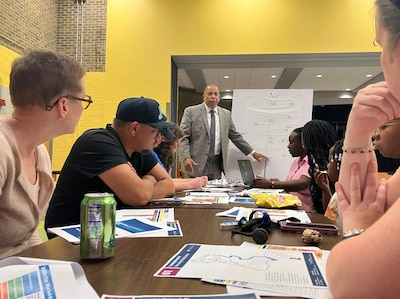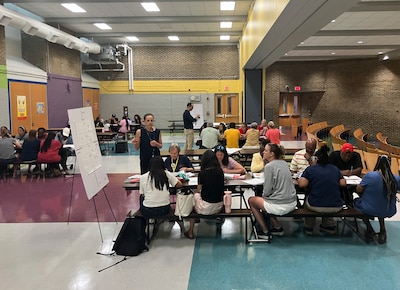Join Chalkbeat Philadelphia’s free publication to maintain up with information on the town’s public college system.
College officers in Philadelphia say closures are coming — and so they’ve promised to make use of knowledge about constructing wants, enrollment, and neighborhoods to resolve which faculties shut their doorways.
However greater than a 12 months into the district’s services planning course of, particulars on which faculties are desperately in want of repairs and which of them are struggling most with enrollment stay murky.
For months, the district has pushed again a promised launch of the knowledge officers have mentioned will inform its suggestions of which faculties to shut, colocate, modernize, repurpose, or keep as they’re. And the info the district has shared — which officers have solely made out there through printouts at group engagement classes — contains severe limitations and inconsistencies, in accordance with principals and educators in attendance.
At group engagement conferences held by the district this month, some educators identified that the district’s said capability for his or her faculties didn’t appear correct, based mostly on their experiences of their buildings. Others famous that the info creates an incomplete image concerning the metropolis’s enrollment, because it solely captures a second in time and doesn’t embrace constitution or parochial college enrollment.
In the end, some principals fear their faculties may very well be focused for closure or colocations based mostly on knowledge that doesn’t precisely mirror their faculties. And a few group members mentioned that failing to holistically overview their faculties’ strengths and challenges might end in choices that hurt kids and neighborhoods.

Many educators and group members attending conferences additionally requested for clarification about how the info could be used to find out college suggestions. Regardless of assigning scores and coloration codes to completely different college components, the district didn’t clarify how these scores and codes might make completely different outcomes for faculties roughly doubtless.
District officers mentioned there was no system, however that they’d take many components into consideration together with feedback and issues shared on the conferences.
“Nothing is etched in stone,” Deputy Superintendent Oz Hill advised a gaggle of educators and group members at an engagement session at Thomas Okay. Finletter College. “We’re nonetheless at some extent the place your enter could make a distinction.”
Chalkbeat’s evaluation of the district’s knowledge revealed additional inconsistencies and gaps. The district supplied Chalkbeat with a listing of every district college’s capability based mostly on its present metrics. However the figures supplied didn’t match the numbers shared through the engagement conferences. For instance, the Abram S. Jenks College is 87% full in accordance with the spreadsheet given to Chalkbeat. However within the printed handouts from the engagement conferences, the varsity has the identical variety of college students enrolled however is marked “severely overcrowded” at over 130% full.
The info the district gave to Chalkbeat additionally didn’t embrace info for a number of faculties, together with faculties that just lately returned to district management after being operated by constitution organizations.
The capability figures the district supplied to Chalkbeat and the capability figures shared on the group conferences have been “collected at completely different time limits,” in accordance with Monique Braxton, a district spokesperson. The district didn’t additional clarify the discrepancies. And up to date capability knowledge for the faculties “might be out there once we launch the general public web site,” Braxton mentioned.
District officers have repeatedly mentioned the info they’ve shared throughout engagement conferences is preliminary and might be up to date after walkthroughs of every college and a overview by principals, a few of whom have been away on trip this summer season.
The brand new knowledge might be launched earlier than the services plan is made public, a number of district facilitators on the conferences mentioned.
However time is operating out. The district plans to solicit suggestions on a draft services plan starting in October, which it should then current to the Board of Schooling in November.
At a session at Thomas Okay. Finletter College, a number of lecturers and faculty leaders affiliated with Feltonville Arts & Sciences expressed issues concerning the college capability numbers the district shared on the conferences.
If the district doesn’t have correct info on its buildings, the educators mentioned, they’ve severe reservations concerning the validity of the method total.
“Don’t make it neat on paper,” mentioned Malcolm Cooper, a music instructor at Feltonville Arts & Sciences, on the threat of creating issues “messy in actual life.”
District’s scores for faculties spur confusion, concern
All through July, district officers hosted greater than a dozen engagement classes to elucidate the services planning course of, solicit suggestions, and share printouts of college knowledge. Chalkbeat attended half of those classes, talking with dad and mom, educators, group members, and district officers in attendance.
The info printouts included enrollment and capability numbers, in addition to color-coded designations for every college based mostly on constructing high quality, neighborhood vulnerability, and program alignment.
District officers mentioned that faculty constructing scores have been based mostly largely on a 2024 constructing audit.
Program alignment scores mirrored whether or not a faculty’s house adequately serves its programming wants, like having a fitness center or house for prekindergarten applications.
Neighborhood vulnerability scores mixed two components. One is the federal Facilities for Illness Management and Prevention’s social vulnerability index knowledge for a faculty’s neighborhood that considers poverty and housing density. The opposite is whether or not a neighborhood has skilled a district college closure previously.
For instance, a faculty with extra college students enrolled than its constructing capability permits could also be marked “crimson” for overcrowding, however have a program alignment of “good,” and a neighborhood vulnerability rating of “reasonable threat.”
In the neighborhood conferences, district officers have mentioned their choices will primarily contemplate the neighborhood vulnerability rating, then a faculty’s capability, utilization, and constructing’s structural situation, after which the additional “nuance” of a faculty group, together with the place college students may very well be moved and what particular applications faculties supply.
However the officers didn’t make a direct connection between how faculties have been ranked on these various factors and the way doubtless it’s that the district would resolve to shut, colocate, or modernize them.
However at each session Chalkbeat attended, not less than one particular person requested for extra readability about how the district arrived on the abstract scores for every college and raised issues about their accuracy.
Luisa Velasquez, co-director of the Associates of Vare-Washington nonprofit that raises cash to help the elementary college, mentioned she believed the “reasonable threat” vulnerability designation assigned to the varsity didn’t mirror the varsity’s actual wants.
Velasquez famous that although extra rich households have moved to South Philadelphia, many have chosen to ship their children to non-public faculties, constitution faculties, or selective admissions faculties. Consequently, the demographics of Vare-Washington Elementary’s neighborhood don’t essentially mirror the varsity’s demographics, she mentioned, “as a result of we’ve children from all around the metropolis coming to us to get an honest training.”
In the same vein, others have famous that the info doesn’t seize the situation of constitution faculties.
Velasquez advised Chalkbeat she left the group assembly skeptical of how the district will use its knowledge for choices about faculties.
College knowledge displays restricted timeline and scope
Deputy Superintendent Oz Hill mentioned the engagement classes to this point have been eye-opening. He urged households to attend extra conferences, which district officers have mentioned will proceed all through the autumn.
“Each single engagement (session), I be taught issues about these faculties and the communities that I didn’t know earlier than,” Hill advised Chalkbeat at one such assembly on Monday.
Some attendees additionally fearful that the capability knowledge was too inflexible. In Northeast Philadelphia, for instance, college leaders mentioned a rising immigrant inhabitants means a faculty’s enrollment can fluctuate all year long. If Feltonville Intermediate College crammed its school rooms to 100% capability on the primary day of college, educators requested what would occur after winter break when a handful of recent college students need to enroll.

Sabrina Scott-Feggins, principal of Normal Philip Kearny Elementary who attended a session on the district’s headquarters, mentioned she nonetheless has questions concerning the district’s course of and calculations.
For instance, since COVID, her college determined to take two underused school rooms and switch them right into a makeshift library as a result of the varsity didn’t have one. Although on paper these rooms might rely as empty, she famous that they’re in use and supply a significant useful resource.
However she mentioned she was heartened by the chance to supply suggestions on to district officers. And as a principal, she will get on board with a call that advantages college students — even when it means reconfiguring faculties.
“I really feel hopeful,” mentioned Scott-Feggins. “I really feel like that is the start of being heard.”
Clarification: This story has been up to date to extra precisely mirror Principal Sabrina Scott-Feggins’ feedback concerning the district’s planning course of.
Rebecca Redelmeier is a reporter at Chalkbeat Philadelphia. She writes about public faculties, early childhood training, and points that affect college students, households, and educators throughout Philadelphia. Contact Rebecca at rredelmeier@chalkbeat.org.
Carly Sitrin is the bureau chief for Chalkbeat Philadelphia. Contact Carly at csitrin@chalkbeat.org.

